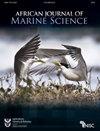Are there long-term temporal trends of size composition and the length– weight relationship? Results for chokka squid Loligo reynaudii during the peak spawning season off the south coast of South Africa
IF 1.4
4区 生物学
Q3 MARINE & FRESHWATER BIOLOGY
引用次数: 0
Abstract
Temporal trends in the size composition (length frequency) and length–weight (L–W) relationship of chokka squid Loligo reynaudii on the south coast of South Africa were assessed over periods spanning 22 years: length frequencies from 1996 to 2017 (with 15 years represented); and L–W relationships over 9 years between 1994 and 2016. To allow for comparison, identical data selection and processing was adopted for all years considered (i.e. identical period of 60 days in spring–summer; the same depths and areas; chokka with empty stomachs; and squid of the same maturity stage). Although there were no significant long-term temporal trends in the mean lengths, there was a significant short-term drop in the mean lengths over the years 2014–2017 (especially in females), which could not be attributed with certainty to any cause. A tentative explanation is that this drop might be linked to the introduction of an additional closed season in these years. The estimated parameters of the L–W relationship also revealed no trend over the years considered. Investigation of the caecum colour, which indicates the state of starvation (white: 8 h on average after food ingestion; yellow: 6 to 7 h after food ingestion), showed significantly more starving males than starving females. Starvation of males on the spawning grounds might be associated with the spawning behaviour of chokka.尺寸组成和长重关系是否存在长期的时间趋势?在南非南部海岸的产卵高峰期,chokka鱿鱼Loligo reynaudi的结果
评估了南非南海岸chokka鱿鱼Loligo reynaudi的大小组成(长度-频率)和长度-重量(L-W)关系的时间趋势,时间跨度为22年:1996年至2017年的长度频率(代表15年);以及1994年至2016年间长达9年的L–W关系。为了进行比较,对所考虑的所有年份都采用了相同的数据选择和处理(即,春季至夏季60天的相同时期;相同的深度和面积;空腹的chokka;以及相同成熟阶段的鱿鱼)。尽管平均长度没有显著的长期时间趋势,但在2014-2017年期间,平均长度出现了显著的短期下降(尤其是女性),这不能肯定归因于任何原因。一个初步的解释是,这一下降可能与这些年额外引入的禁渔季节有关。L–W关系的估计参数也没有显示出所考虑年份的趋势。盲肠颜色的调查表明了饥饿状态(白色:食物摄入后平均8小时;黄色:食物摄入后六至七小时),表明饥饿的雄性明显多于饥饿的雌性。产卵场雄性的饥饿可能与乔卡的产卵行为有关。
本文章由计算机程序翻译,如有差异,请以英文原文为准。
求助全文
约1分钟内获得全文
求助全文
来源期刊

African Journal of Marine Science
生物-海洋与淡水生物学
CiteScore
2.60
自引率
16.70%
发文量
17
审稿时长
6-12 weeks
期刊介绍:
The African (formerly South African) Journal of Marine Science provides an international forum for the publication of original scientific contributions or critical reviews, involving oceanic, shelf or estuarine waters, inclusive of oceanography, studies of organisms and their habitats, and aquaculture. Papers on the conservation and management of living resources, relevant social science and governance, or new techniques, are all welcomed, as are those that integrate different disciplines. Priority will be given to rigorous, question-driven research, rather than descriptive research. Contributions from African waters, including the Southern Ocean, are particularly encouraged, although not to the exclusion of those from elsewhere that have relevance to the African context. Submissions may take the form of a paper or a short communication. The journal aims to achieve a balanced representation of subject areas but also publishes proceedings of symposia in dedicated issues, as well as guest-edited suites on thematic topics in regular issues.
 求助内容:
求助内容: 应助结果提醒方式:
应助结果提醒方式:


